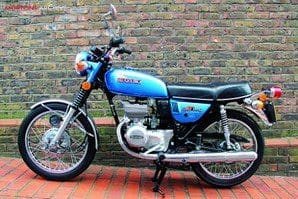
Describe a motorcycle as delightful these days and you’ll get a strange look. Motorcycles aren’t delightful. They’re awesome, amazing, stunning.
But there was a time when the term fitted comfortably into the lexicon of motorcycle terminology. And it fitted Suzuki’s little GT185 two-stroke twin perfectly. It was in the early 70s, when Suzuki had revamped its range of two strokes. Until then, the Hamamatsu factory had offered twins based on the amazingly fast Super Six 250 sports bike, which grew into a 315cc twin followed in 1968 by the 500cc Cobra.
Monstrous proportions
It all changed in 1971 when the water-cooled three-cylinder GT750 was launched, a machine of such monstrous proportions that it truly invoked awe. It was soon followed by air-cooled triples in 380cc and 550cc sizes which, like the 750, tried to ape the newly-introduced four-stroke fours from Honda and Kawasaki by having two silencers either side. They were like comfy sofas on wheels, except a sofa got better fuel consumption.
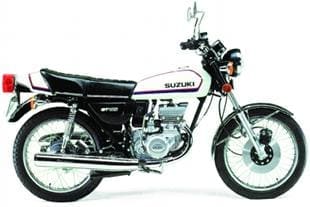 Suzuki followed the theme with a pair of lightweight twins, the GT125 and GT185, the common thread being that the engines used the so-called Ram Air System. Unlike conventional practice in which the cylinder head had vertical cooling fins, Suzuki’s engineers devised a cowl that was either cast into the head or bolted over the fins. The idea, or so we were told, was that cooling air was ducted across the head rather than escaping either side. For the air-cooled triples, whose centre cylinder might otherwise have suffered from overheating, it made some sense. But for the twins, it was more like marketing hype.
Suzuki followed the theme with a pair of lightweight twins, the GT125 and GT185, the common thread being that the engines used the so-called Ram Air System. Unlike conventional practice in which the cylinder head had vertical cooling fins, Suzuki’s engineers devised a cowl that was either cast into the head or bolted over the fins. The idea, or so we were told, was that cooling air was ducted across the head rather than escaping either side. For the air-cooled triples, whose centre cylinder might otherwise have suffered from overheating, it made some sense. But for the twins, it was more like marketing hype.
It was perhaps one of the first instances of the marketing people getting their fingers into the design of a motorcycle engine. But as a rookie on the weekly paper Motor Cycle, I tried not to let the hype cloud my judgement when I tested the GT185 in the summer of 1973.
I thought the bike was great fun, despite it having a few glaring faults in its design. How come? Japanese lightweights had long been running rings around British heavyweights; now they were taking on a new style with bright metallic colours and generous use of brightwork. But what made the little Suzuki delightful was its nimble handling and positive steering. Even a passing vintage bike fan called it ‘a little darling!’ much as he might describe a James Captain.
Weighing just 280lb, or 127kg, you could fling the Suzuki over to the limits of its generous cornering clearance and even though its tyres and suspension were rudimentary, it didn’t seem to matter.
This was a bike that wa s ideal for the just-qualified rider, who didn’t need, or want, a bigger or sportier machine. Yet while bikes would take 20 more years to evolve into machines that could be used without much modification for racing, the GT185 still offered enough visual cues to satisfy the sports fan. Take, for example, the large drum front brake with twin leading shoes, or the skimpy front mudguard blade, both of which looked like they’d come from a works bike of the 60s. The big headlamp gave the bike an air of authority. Rubber bellows covering the front fork legs offered a feel of enduring quality. It was also roomy with a precisely balanced riding position that worked both in the showroom and on the road.
s ideal for the just-qualified rider, who didn’t need, or want, a bigger or sportier machine. Yet while bikes would take 20 more years to evolve into machines that could be used without much modification for racing, the GT185 still offered enough visual cues to satisfy the sports fan. Take, for example, the large drum front brake with twin leading shoes, or the skimpy front mudguard blade, both of which looked like they’d come from a works bike of the 60s. The big headlamp gave the bike an air of authority. Rubber bellows covering the front fork legs offered a feel of enduring quality. It was also roomy with a precisely balanced riding position that worked both in the showroom and on the road.
Yamaha had already set the scene with its 195cc CS5E that I’d tested almost a year earlier. It was a little hot-rod, and derived from a 125cc two-stroke twin, felt almost too potent for its spindly chassis.
Completely fresh
Suzuki’s take on the class was – at first sight – completely fresh. Although the 185cc twin used the same basic engine and frame as the 125cc model, both were new designs without any previous lineage. The engine was novel in that while it used conventional horizontally-split crankcases, they were tipped up at the front so that the axes of the air-cooled cylinder barrels were vertical, ostensibly to help their cooling.
Both the 185 and 125 shared similar crankcases, with the pressed-up crankshafts running in roller bearings. While the bigger engine’s bore and stroke of 49 x 49mm gave a swept volume of 184cc, the smaller measured 43 x 43mm for 124cc. A wet multiplate clutch on the mainshaft and driven by helical gears fed the five-speed gearbox. Checking through a Suzuki booklet that covered the specifications and service data of its bikes up to 1973 revealed that the internal gear ratios were identical to those used by the TS125 and TS185 trail bikes, indicating that its engineers were sensibly using already proven components.
Unlike the Yamaha w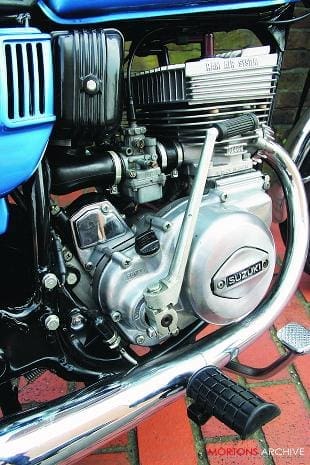 hich used reed-valve assisted intake ports, the GT185’s twin 20mm-choke Mikuni carburettors were mounted on simple rubber stubs. No surprise then that the claimed maximum power of 21bhp at 7500rpm was at the peak of a narrow usable band.
hich used reed-valve assisted intake ports, the GT185’s twin 20mm-choke Mikuni carburettors were mounted on simple rubber stubs. No surprise then that the claimed maximum power of 21bhp at 7500rpm was at the peak of a narrow usable band.
What it did share with the Yamaha was a starter motor. Novel for lightweights at the time, the Suzuki used a dynamo that doubled as a starter motor on the left-hand end of the crankshaft under a larger cover than the 125’s which didn’t have the luxury, just a kick start lever. Outboard of the dynamo was a pair of contact breakers for the ignition, typical for the period.
Firing up was just a matter of turning on the fuel tap, lifting the mixture enrichening lever on the carbs and tapping the starter button adjacent to the twistgrip to connect the 12-volt 11-amp-hour battery. The engine fired immediately to idle with a slight rattle from the top end. At the time, the light-alloy cylinders still used iron liners with larger clearances than later two-strokes with hard-coated bores.
Snapping the twistgrip produced a distant moan from the intakes and a crisp popping from the pipes, with a typical misfire on the over-run. But snicking into bottom gear revealed the first of a number of niggling flaws. The gear lever had been lengthened to clear the larger dynamo cover and had excessive slack in its movement. Inspection revealed that to move the lever’s pivot point back an additional internal linkage was used to connect it to the change mechanism.
Smooth and responsive
Once on the move, the bike felt smooth and responsive, the rubber-mounted engine singing up through the gears to reach more than 80mph on the speedo. And that was without resorting to a crouch. Best change-up revs were about 7800rpm when there was the barest tingle felt through the footrests.
With a tight 51in wheelbase, the 185 could be flicked over confidently through bends with the tips of the rubber footrests skimming the road surface, and that felt like a long way. The suspension, twin shocks at the rear and a telescopic front fork proved to be stiff and rudimentary and just adequate for the performance.
But then, when a sharp stop was needed, the next problem reared its head. Despite its potent looks, the front brake was more of a heart stopper. First application resulted in measured slowing, but firmer action failed to provide anything better. The rear brake felt the more effective of the two.
The next surprise was t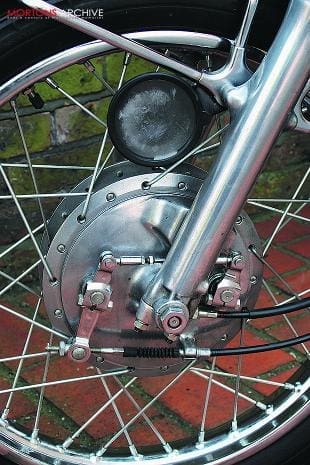 he early sign that you were running low on fuel. Barely 80 miles after topping up, you’d need to switch to the reserve on the 2.2-gallon tank. Whether it was because the bike encouraged spirited use or not, a lightweight that couldn’t better 50 miles to a gallon was really disappointing. Fortunately, the engine’s lubrication system, with a pump controlled by throttle opening, was lean in the extreme, drawing a pint every 500 miles from the under-seat tank and returning a petrol-oil ratio of 90 to 1, something like four times better than usual.
he early sign that you were running low on fuel. Barely 80 miles after topping up, you’d need to switch to the reserve on the 2.2-gallon tank. Whether it was because the bike encouraged spirited use or not, a lightweight that couldn’t better 50 miles to a gallon was really disappointing. Fortunately, the engine’s lubrication system, with a pump controlled by throttle opening, was lean in the extreme, drawing a pint every 500 miles from the under-seat tank and returning a petrol-oil ratio of 90 to 1, something like four times better than usual.
Confirmation of the contrasts in the Suzuki’s performance came in June 1973 at MIRA’s proving ground, where the top speed, acceleration and fuel consumption could be measured with electronic equipment.
Flat out in my racing leathers, I coaxed the GT185 up to 8300rpm – 300rpm into the red – for a best one-way speed of almost 81mph. The mean top speed, and average of two opposed runs, was 79.6mph. That was only slightly down on the Yamaha CS5E I’d tested in 1972.
The Suzuki’s acceleration was almost identical to the Yamaha as well; a standing quarter mile was despatched in just over 18 seconds. Zero to 60mph came up in about 10 seconds, so it could easily blow off the average car.
Confirmed what I expected
Constant speed fuel consumption tests confirmed what I’d expected: at low speeds the Suzuki was OK but at above 50mph it plummeted to 50mpg and worse. Then came the braking test from 30mph. The measure of a reasonably good stopper was that it could pull up from that speed, under control, in 30 feet or better. The GT185 sailed on to 36ft 6in with a feeling of falling off a cliff. Whether this was because of poor adjustment or weak linings I never knew. But a recent ride on a restored version felt just the same.
I’d been reasonably happy with the top speed – until a month later when Yamaha offered its latest RD200, an update of the CS5E. Outwardly similar, it was in fact a rocket, clocking a mean two-way top speed of 88.5mph, or easily into 250 territory. Acceleration was also much better, with a quarter mile time half a second quicker than the Suzuki. The Yamaha was in a class of its own.
Three years later in 1976 I tested the GT185 again. This was the GT185A model which, stylewise, had lost the fork bellows, gained a lower clip-on ‘ace’ style handlebar and, reassuringly, acquired a disc front brake, a feature that had been adopted two years earlier.
 None of the earlier model’s handling qualities had been lost. Indeed, I called it ‘a super scratcher’s machine’ with generous cornering clearance and fairly grippy, at least in the dry.
None of the earlier model’s handling qualities had been lost. Indeed, I called it ‘a super scratcher’s machine’ with generous cornering clearance and fairly grippy, at least in the dry.
With slightly taller gearing, acceleration to about 60mph was brisk but then tailed off, limiting the cruising speed to an indicated 70mph. Braking with the disc was vastly better than with the drum, so much so that the front fork would twist under hard use.
Fuel consumption, too, was better, with an average of 49.5mpg. And it was even leaner with the oil, the tank only needing a third of a pint after 214 miles of use. I was also impressed with the level of equipment; the six-inch diameter 35-watt headlamp was good for 55mph at night, the large rubber-mounted rear-view mirrors blur-free, the toolkit generous and the stands, both centre and side, solid and secure. It even had a red warning light that illuminated when the electrical charging balance showed that the battery wasn’t being fed below 2000rpm.
Around the same time, I tested the smaller-capacity but otherwise identical GT125A twin at MIRA. It was a surprise and revealed the performance weakness of the 185. Flat out, the 125 clocked an average 75.3mph, just 4mph down on the 185, and well up on many eighth-litre machines. And through the quarter mile it was just 0.1 seconds down on the bigger bike, with a time of 18.15sec with a terminal speed of 69.4mph. True, overall fuel consumption was just as bad with an average of 41mpg, but it showed that there was something wrong with the 185’s power characteristics.
Designed against the clock
My conclusion is that the GT185’s engine had been designed against the clock, and although it performed reasonably well the bike clearly didn’t get any subsequent development attention to anything but the absolute necessities.
But delightful? Yes. As early lightweights go, the GT185 was more memorable than most. Had it not been for the blindingly impressive RD200, it would have been in the spotlight.
Suzuki GT185 owner Sam Said has been a two-stroke fan since he was a teenager in the late 70s when he was introduced to the joys of powered two-wheelers with a Honda C70. He was bitten and soon after his 16th birthday bought a Yamaha FS1E. “A bike that defined the 70s,” he said.
That was followed by an RD200, but his allegiance to ring-dings faltered when he bought a Honda CB250 four-stroke twin, was revived with a Suzuki GT380 triple and again was overpowered with Honda CB400F.
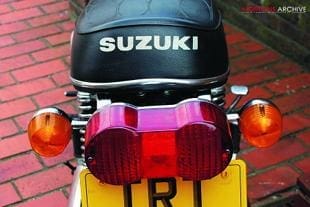 A South Londoner who runs an automotive security business, Sam rode four-strokes through the 90s. Then his interest in two-strokes was reawakened and now he has a garage full of immaculate examples from the early 70s. Biggest is his favourite, a Suzuki GT750 water-cooled triple from 1975, most likely an A model but he’s not sure, and smallest a rare Yamaha L5T trail bike from 1969 that uses an electric-start version of the 50cc FS1E engine. In between is his latest acquisition, a Suzuki TS125K trail bike, a 1974 Yamaha RD200 twin and an immaculate RD350 twin of similar vintage that originated from Italy and features light-alloy wheel rims and twin discs.
A South Londoner who runs an automotive security business, Sam rode four-strokes through the 90s. Then his interest in two-strokes was reawakened and now he has a garage full of immaculate examples from the early 70s. Biggest is his favourite, a Suzuki GT750 water-cooled triple from 1975, most likely an A model but he’s not sure, and smallest a rare Yamaha L5T trail bike from 1969 that uses an electric-start version of the 50cc FS1E engine. In between is his latest acquisition, a Suzuki TS125K trail bike, a 1974 Yamaha RD200 twin and an immaculate RD350 twin of similar vintage that originated from Italy and features light-alloy wheel rims and twin discs.
The GT185, a drum-braked 1973 model, found its way into Sam’s collection after the Kettle Club restored it as a raffle prize. The winner didn’t want the bike so Sam bought it for an undisclosed sum from the club. In mint condition, the only clue to its history is the use of later-version exhaust pipes, says Sam.



